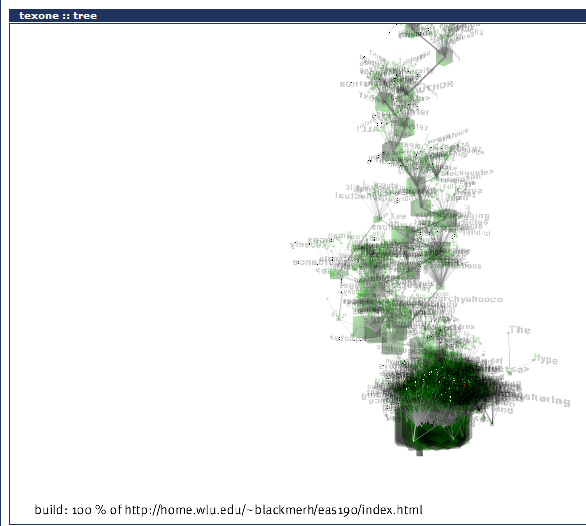
Cyberspace is part of the real world right now. A lot of the early science fiction and technologies such as VR focused on the image of immersion and even when we talked about ubiquitous computing, we were talking about little screens everywhere. Portals to cyberspace. With mobile phones, the "thumb tribe" or "oyayubizoku" in Japanese can blind text with their hands in the pockets. For these kids, real world and cyberspace are one. Their friends are at their fingertips. They are sharing co-presence with their tribe. The Net is not about content or screens, it’s about presence and community. With RFID (Radio Frequency Identification), machines join this integrated network. Sure, our eyes are important and augmented reality will soon be a part of our daily lives, but for kids who don’t remember what’s it’s like not to have SMS (short message service) and the Internet, the word "immersion" probably doesn’t make too much sense. Generally speaking, everything is continuous-partial-attention.
(Joi Ito, interviewed by R.U. Sirius)
EPIC In the year 2014... (The World: Googlezon And The Newsmasters EPIC) and transcript
Amazon concordance
Craigslist / Google Maps mashup
The Long Tail on Mainstream Media Meltdown (and we need to talk about The Long Tail generally)
Consider the implications: The Sony Librie ...and note trackbacks
OhMyNews.com from Korea (hear a clip of Dan Gillmor describing the phenomenon)
EAS 190 forest:
=====
Hsiang-san says: "...a specific target in mind for research: A comparative study of the effects of women participation in the workforce. In my Econ of Japan class, we spent a significant amount of time discussing the economic implications of women working, I decided for my research to focus on the social implications.After browsing through the websites, I found J-stor to be most helpful, however sometimes its articles are not very recent."
Two things here: JSTOR is a full text archive... especially useful because of its temporal depth; but it doesn't cover the last few years, by design and by licensing arrangements. And maybe we should explore Annie a bit, to get our bearings and develop some terminology.I did a quick Annie search for 'workforce AND japan' and the topmost item is a Bingo:
AUTHOR Bishop, Bev....and the SUBJECT Heading 'Women -- Employment -- Japan' takes us to this summary, which fingers 15+ items to explore. I made a set of 7:
TITLE Globalization and women in the Japanese workforce
IMPRINT London ; New York : Routledge, 2005.
CALL NO. HD6197 .B574 2005.TITLE Japanese women working / edited by Janet Hunter.What can we say about this set?
IMPRINT London ; New York : Routledge, 1993.
CALL NO. HD6197 .J355 1993.AUTHOR Lo, Jeannie, 1965-
TITLE Office ladies/factory women : life and work at a Japanese company
IMPRINT Armonk, N.Y. : M.E. Sharpe, c1990.
CALL NO. HD6197 .L6 1990.AUTHOR Kondo, Dorinne K.
TITLE Crafting selves : power, gender, and discourses of identity in a Japanese workplace
IMPRINT Chicago : University of Chicago Press, c1990.
CALL NO. HD6197 .K658 1990.TITLE Re-imaging Japanese women / edited and with an introduction by Anne E. Imamura.
IMPRINT Berkeley, Calif. : University of California Press, c1996.
CALL NO. HQ1762 .R45 1996.AUTHOR Roberts, Glenda Susan, 1955-
TITLE Staying on the line : blue-collar women in contemporary Japan
IMPRINT Honolulu : University of Hawaii Press, c1994.
CALL NO. HD6073.C62 J37 1994.AUTHOR Brinton, Mary C.
TITLE Women and the economic miracle : gender and work in postwar Japan
IMPRINT Berkeley : University of California Press, 1993.
CALL NO. HD6197 .B75 1993.AUTHOR Kelsky, Karen, 1964-
TITLE Women on the verge : Japanese women, Western dreams
IMPRINT Durham [N.C.] : Duke University Press, 2001.
CALL NO. HQ1762 .K45 2001.
And here's something else I happened upon, a Yahoo feature that seems to allow searching of the TEXT of pdfs... still not sure about how to make an interface, but here's a small set of pdfs including 'Japanese workforce' ...e.g., What Does It Mean for Women in the Workforce?
And while we're on the subject of terminology: 'workforce'/'work force': two Google Scholar searches: "japanese women" workforce (334) and "japanese women" "work force" (142)
Some factoids: "... Although Japanese women constitute 40% of the workforce (“Women in Japan,” 1992), only 8% of all managers are women (“Unequal Race,” 1993)..."=====and
The Equal Employment Opportunity Law: A Decade of Change for Japanese Women?
Author: Gelb J.
Source: Law & Policy, October 2000, vol. 22, no. 3-4, pp. 385-407(23)
Publisher: Blackwell Publishing
Abstract:
This article analyzes the impact of the Equal Employment Opportunity Law in Japan, passed in 1986 and now over a decade old. The article views the law as weak and examines its role in relation to the three groups most affected by the legislation: women, bureaucrats, and employers. The article argues that, although the law has produced few gains in employment opportunities for women, it has led to renewed efforts at litigation, increased consciousness and activism among women, and amendments to the law, passed in 1997.
The full text article is available for purchase: $37.70
BUT Annie says W&L has in paper
Alan: Smartest Guys in the Room: The Amazing Rise and Scandalous Fall of Enron (2003)
BoingBoing 25 April 2005 ...leads me to the phrase "rank and yank"